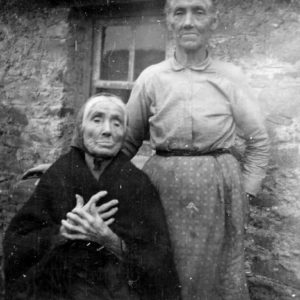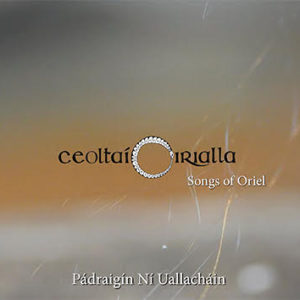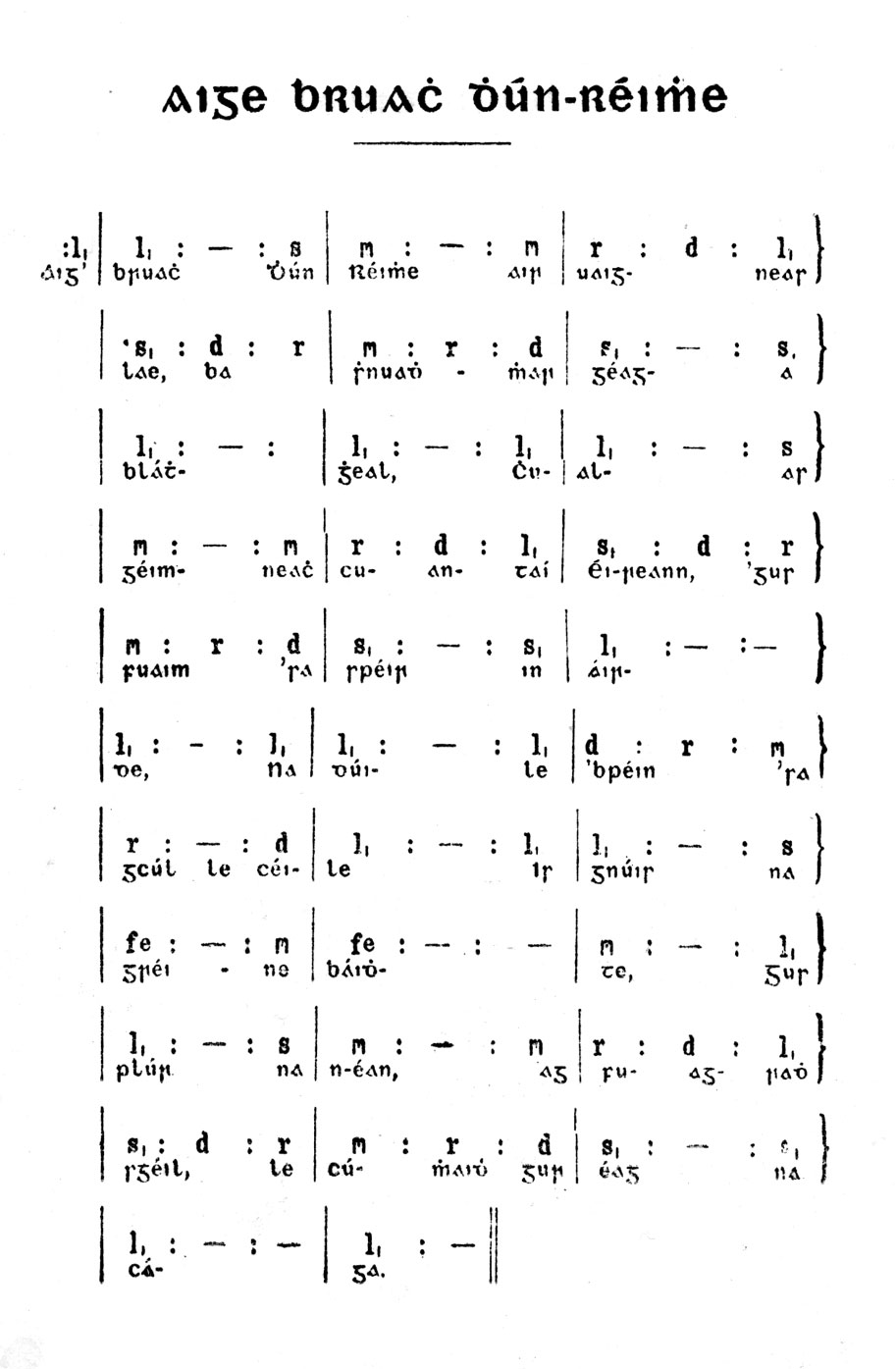Mairgne fá Chaisleán na Glasdromainne
Background
(see A Hidden Ulster pp. 259-64 for detailed references and information)
This song is variously entitled Bruach Dhún Réimhe and Mairgne fá Chaisleán na Glasdromainne. This song expresses a poignant lament for the downfall of the Ó Néill chieftain castle which was built on the edge of Dunreavy wood on the shores of Glasdrumman Lake in south Armagh.

Glasdrumman Lake, County Armagh – site of O’Neill castle.
There are only fragmentary traces of this great castle in the stony ground above the tranquil waters of Glasdrumman Lake. There was once, reputedly, an unusual white flower growing around the rock, where the castle had stood, called ‘Ó Néill’s flower’ which, according to tradition, was originally transplanted from Spain.
The song was written during a storm when the poet was taking shelter there, in the ruins of Glasdrumman Castle. A song thrush rises near him, symbolizing the waning spirit of the Ó Néill, and the song is written as an address to the bird. The Ó Néill clan had gone to Spain where they had sought ‘noble recognition’ from the court of Spain, and only their ancestors’ bones remained in Creggan.

The burial place of the O’Neill of the Fews chieftains in Creggan graveyard near Crossmaglen County Armagh.
Glasdrumman castle was built on the extreme southern borders of the country belonging to the Ó Neill chieftains. From this castle there is a clear view of Dundalk bay about eight miles away and of Roche Castle or Dún na nGall (The Fort of the English), as it was locally called. Roche Castle stood on the far northern borders of the Pale, which was under English rule. Roche has survived in stone, while Glasdrumman, the main castle on the southern-most border of Ó Néill land, is remembered in song.
The collector Lorcán Ó Muirí (AHU pp. 358-60) regarded this as Art Mac Cumhaigh’s most melodious song. His poems cannot be disassociated from the history of the Ó Néill of the Fews. Mac Cumhaigh dreamed of the restoration of their power and their patronage. His songs which survived in manuscript and in the songs of the people, helped to keep the traditions of the Ó Néills of Glasdrumman, Dunreavy and Creggan alive in the people’s imagination. His poems leave a wealth of historical references and in them he brooded continuously over the loss of the O’Neills and the loss of their patronage.
The castle was built towards the end of the sixteenth century. It was badly damaged in the 1641 wars, and Eoghan Ó Néill lost possession of it in 1655. A Cromwellian called Thomas Ball in 1711 later occupied it. A local man, called Patrick Murphy, who had leased it, then caused its final destruction by destroying it, and ‘obliged his masters by pulling down the five century old castle’. Local tradition has it that he used the stones to build a house and a road nearby.
Oriel Arts © Pádraigín Ní Uallacháin CÉ 2020
Transmission

Mrs Mary Harvessy and her daughter Mary c. 1915. Photo Peadar Ó Dubhda. copyright A Hidden Ulster 2017
The words and music were written down in tonic solfa from singer Mrs Mary Harvessey, (AHU pp 391-2) from Clonalig, near Crossmaglen, County Armagh, She was born around 1830 (57 years after the poet’s Art Mac Cumhaigh’s death) . She was the main source of songs written by this celebrated poet (AHUpp. 350-1; pp. 250-84) whose songs were very popular in the songs of the people of Oriel.
Her daughter Mary on right in the photograph was recorded reciting a few verses by Wilhelm Doegan (AHU pp. 386-7) in 1931.
 Her mother Mrs Mary Harvessy, Máire Uí Arbhasaigh claimed kinship with the poet on her father’s side. She had learned her songs from her mother and grandmother, which included at least four songs by Mac Cumhaigh. It is likely that her version came directly down from the poet himself, who died in 1773.
Her mother Mrs Mary Harvessy, Máire Uí Arbhasaigh claimed kinship with the poet on her father’s side. She had learned her songs from her mother and grandmother, which included at least four songs by Mac Cumhaigh. It is likely that her version came directly down from the poet himself, who died in 1773.
It is recorded on Ceoltaí Oirialla – Songs of Oriel 2017
Oriel Arts © Ceoltaí Éireann 2018
Traditional singer, Eithne Ní Uallacháin recorded it on her first Gael Linn CD Cosa gan Bhróga, under the title of Bruach Dhún Réímhe. Eithne’s version was later recorded by Donegal traditional singer, Mairéad Ní Mhaonaigh. Feilimí first learned this song from his mother, Eithne Ní Uallacháin. She sings it her with keyboard accompaniment from Jim Corr.
Bruach Dhún Réimhe: Eithne Ní Uallacháin COSA GAN BHRÓGA CD ©Gael Linn le caoinchead.

Oriel singer and Flute player Eithne Ní Uallacháin. copyright O’Connor Family 2017

Feilimí O’Connor singer and film director for ORIEL ARTS 2017. Photo. M. Ó Graham
Words
Edited from:
- Aige bruach Dhún Réimhe: Amhráin Chúige Uladh 1927,23, from Mary Harvessy, Crossmaglen. Mairgneach faoi Chaisleán na Glasdromainne: T. Ó Fiaich, Art Mac Cumhaigh – Dánta (1973, 79 (9 verses).
- Mairgne fá chaisleán na Glasdromainne: B. Ó Buachalla, Nua Dhuanaire 1976, 39 (9 verses).
Mairgne fá Chaisleán na Glasdromainne
Ag bruach Dhún Réimhe ar uaigneas lae,
Ba shnuamhar géagaibh bláthgheal,
Chualas géimneach chuantaí Éireann
Agus fuaim sa spéir in airde;
Bhí na dúilibh i bpéin is a gcúl le chéile,
Is gnúis na gréine báite,
Is plúr na n-éan ag fúagradh scéil
Le gruaim gur éag na cágaibh.
Ba chloíte mé ’mo luí i bpéin
Go bhfuighinnse scéal an ábhair,
Nó an é críochnú an tsaoil mar a mhíníos cléir
A bhí ’triall ar Ghaeil an lá sin?
Bhí úafás gaoithe is fuaim san aer
Le síorchur laidhge is táirneach;
Is ualaí éisc le gruaim gur éag
’Na gcuail ar thaobh na trágha.
Tráth chonaic mé an spéir is gach ní faoin ghréin,
Is an saol faoi éiclips ábhal;
Shíl mé féin gur mithid domh téitheadh
Go dún na gcraobh is na fáilte.
D’éirigh an smaolach cumhra béilbhinn
Suas ar ghéagán láimh liom;
Is ba bhinne ná téadaibh milse Orpheus
Ceiliúr an éin do b’áille.
A smaolaigh chléibh, ó (t)chí tú féin
Gur claoíodh Gaeil na háite,
Tabhair éirí léim i lúb an aeir
Is beir sitheadh i gcéin ar sáile;
Mar a bhfaighidh tú fréamh de ghaol Uí Néill
I dtíorthaibh tréan na Spáinne,
Agus ársaigh don té a mhaireas ón éag
Gur scaoileadh an aolchloch álainn.
Tráth chuala(idh) an t-éan mé a’ lua shíol Néill,
Le gruaim gur éirigh in áirde;
Bhí a sciatháin scaoilte síos go féar
Agus bhuail sé a thaobha go cráite;
A dúirt gur bhuartha baoth mo scéal
Ó chuaigh faoi liagaibh sparrtha,
Is da gcuartó(ch)ainn féin na tuambaí céanna
Gurb ualach cré ’gus cnamha iad.
‘Go Tír Eoghain má their, gheobhair póg is céad,
Is treorú an scéil go dáimhiúil;
Mar a bhfuil na laochra is dílse méin,
’Tá lúfar, tréitheach, láidir’.
Tá an cháin seo réidh chun sásamh an té
’Bheir smál ar Ghaelaibh an lá seo;
A phlúir na n-éan, ná humhlaigh don éag,
Nó go dtiocfaidh sliocht Néill do d’ tharrtháil.
Ó bhreoigh tú mé le glór do bhéil,
’S nach bhfóghthar le leigheas ón bhás mé,
Go Cúige Laighean is cóir dúinn gléas,
Go Dún Uí Néill ar mársáil;
Ór na Gréige is stór na hÉiphte
Is ceol na dtéad ar chlársaigh;
Is ní fhóirfeadh an méid sin, is foghaim go léir é
A stór, mura n-éagfainn láimh leat.
Lament for the Castle of Glasdrumman
On the edge of Dunreavy at the fall of evening,
The white-bloomed boughs were fine
I heard the horns from Ireland’s shores
And the rumbling skies on high;
All nature in torment, together in conflict;
The face of the sun was in shade;
And the fairest of birds was announcing with song,
In sorrow that the crows had died.
I was overcome as I lay in pain,
Till I’d hear what had caused the affray,
Or had the end of life come, as clergy describe,
For the people of Ireland that day?
Fierce winds and gales in the air, they raged
With unceasing thunder and snow,
And the shoals of fish, in dismay, had died
Heaped up on the edge of the shore.
On seeing the sky and all under the sun,
And life in one great eclipse,
I felt it was timely to make my escape
To the friendly and laurelled place.
The lovely song thrush rose there up above me,
Near on a branch in the trees,
More tuneful by far, than the sweet strings of Orpheus,
The most beautiful bird as she sings.
My own dearest bird, you yourself see
That the Gaels of this place were all slain,
Endeavour to rise in the hovering skies
And swoop out abroad o’er the main,
Where you will find a branch of Ó Néill
In the powerful lands of Spain,
And tell to the one who now survives death
That the beautiful lime-walls are down.
Once the bird heard me mention the seed of Ó Néill,
In sorrow she rose up to fly,
Her loose flapping wings were trailing the earth
And she woefully beat at her sides;
Who said that my words now no longer had purpose
Since they went beneath bolted stone,
And if I were to search around the same tombs,
In a mound, they were clay and bones.
If you go to Tyrone you’ll get kisses galore,
And guidance for you with love;
Where live the heroes, most loyal of nature,
Who are agile and gifted and strong;
This law is prepared as revenge by the one
Who oppresses the Irish this day;
So fairest of birds, don’t bow down to death,
Till Ó Néill’s tribe will come to your aid.
You have wounded me sore with the sound of your words,
For no cure will now save me from death,
To the Province of Leinster we aught now to go
And march to Ó Néill’s strong fort;
The gold of Greece or the wealth of all Egypt,
And music of strings played on harp,
All this cannot ease me, and I gain it all,
My love if we die apart.
Translation: P. Ní Uallacháin
Oriel Arts © Ceoltaí Éireann 2018
Music
Aige Bruach Dhún Réimhe: Amhráin Chúige Uladh, 1927, 23– from Mary Harvessy in tonic solfa. It was later re-edited and published in staff notation bt Dr Colm Ó Baoill in Amhráin Chúige Uladh 1977. It is a splendid air in sonata form, with an effective use of the flattened 4th in the rise of the air.
Oriel Arts © Ceoltaí Éireann 2018

Aige Bruach Dhún Réimhe
